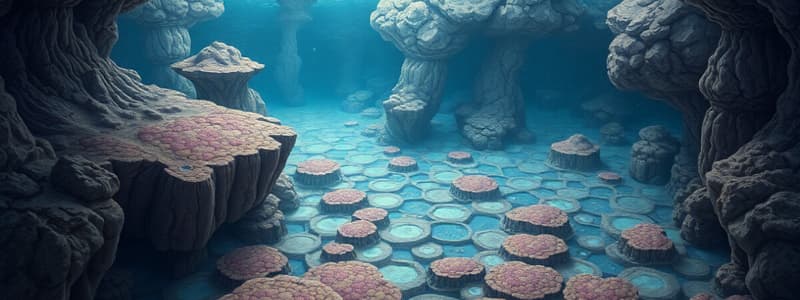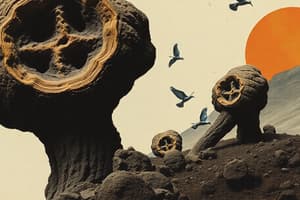Podcast
Questions and Answers
What primarily makes up stromatolites?
What primarily makes up stromatolites?
- Calcium carbonate precipitated by microbial mats (correct)
- Clay minerals and sediments
- Iron compounds and algae
- Silica and organic matter
What environmental conditions are stromatolites most strongly associated with?
What environmental conditions are stromatolites most strongly associated with?
- Deep ocean currents and cold temperatures
- Shallow, warm, and often saline waters (correct)
- Freshwater lakes with high nutrient levels
- Mountain streams with rapid flow
How do microbial mats contribute to the formation of stromatolites?
How do microbial mats contribute to the formation of stromatolites?
- They trap and bind sediments while precipitating minerals. (correct)
- They provide a habitat for larger organisms to thrive.
- They absorb carbon dioxide from the atmosphere.
- They decompose organic materials, releasing nutrients.
What variation can be observed in stromatolite structures?
What variation can be observed in stromatolite structures?
What does the geological record indicate about stromatolites during the Phanerozoic Eon?
What does the geological record indicate about stromatolites during the Phanerozoic Eon?
What insights do modern stromatolites provide to researchers?
What insights do modern stromatolites provide to researchers?
Stromatolites are significant in the study of early life because they are considered what?
Stromatolites are significant in the study of early life because they are considered what?
In what type of environments are modern stromatolites typically found?
In what type of environments are modern stromatolites typically found?
Flashcards
What are stromatolites?
What are stromatolites?
Layered structures formed by the growth of microorganisms, particularly cyanobacteria.
How do microbial mats contribute to stromatolite formation?
How do microbial mats contribute to stromatolite formation?
They trap and bind sediments, leading to the gradual accumulation of layers.
What is the main mineral component of stromatolites?
What is the main mineral component of stromatolites?
Calcium carbonate, precipitated by microbial activity, forms the distinct layers that characterize stromatolites.
How are stromatolites significant in understanding ancient environments?
How are stromatolites significant in understanding ancient environments?
Signup and view all the flashcards
Where can modern stromatolites be found?
Where can modern stromatolites be found?
Signup and view all the flashcards
What happened to stromatolites throughout geologic time?
What happened to stromatolites throughout geologic time?
Signup and view all the flashcards
Why are stromatolites important in the study of early life?
Why are stromatolites important in the study of early life?
Signup and view all the flashcards
What are some types of stromatolite structures?
What are some types of stromatolite structures?
Signup and view all the flashcards
Study Notes
Introduction to Stromatolites
- Stromatolites are layered sedimentary structures formed by the growth of microorganisms, primarily cyanobacteria.
- They are among the oldest known fossils, providing insights into early life forms and Earth's ancient environments.
- These structures are typically found in shallow marine waters, but have also been observed in some freshwater environments.
- Stromatolites are composed of calcium carbonate precipitated by microbial mats.
Formation and Structure
- Microbial mats, often dominated by cyanobacteria and other photosynthetic microbes, trap and bind sediments.
- These mats gradually accumulate and precipitate minerals, primarily calcium carbonate, forming layers.
- The alternating layers of microbial growth and mineral precipitation lead to the characteristic layered morphology of stromatolites.
- Different species of microbes can contribute to the formation, affecting the structure of the stromatolite.
- Some stromatolites display complex three-dimensional structures, while others have simpler, more planar layers.
Types of Stromatolites
- Different shapes and structures are dependent on the environment and specific microbial composition.
- These structures can vary, with some exhibiting dome-like shapes, others having columnar or sheet-like forms.
- The complexity varies significantly, from simple layered structures to intricate, mound-shaped formations.
Geological Significance
- Stromatolites are valuable indicators of ancient environments, specifically of shallow, warm, and often saline waters.
- They are linked to specific environmental conditions, providing insights into past sea levels, nutrient availability, and water chemistry.
- They are important in correlating rock layers and understanding past geological processes.
- The geological record shows a decline in stromatolite abundance throughout the Phanerozoic Eon.
Modern Stromatolites
- Some stromatolites are still being formed today in a variety of sites around the globe.
- These modern counterparts provide insights into the processes that created the ancient structures.
- Modern stromatolites are found in hypersaline environments and other restricted aquatic settings with limited disturbances.
- They are often found in places with high temperatures and low oxygen levels.
Importance in the study of Early Life
- Stromatolites are often considered the first evidence of life in the Earth's geological record.
- The high oxygen levels formed by cyanobacteria, essential for stromatolite creation, revolutionized life on Earth.
- Their presence demonstrates an initial rise in atmospheric oxygen.
- Fossilized stromatolites offer insights into the structure and ecosystem of early microbial communities.
Applications
- They are crucial in determining environmental conditions and ecological dynamics in ancient environments.
- Researchers utilize their morphology and growth patterns for age estimations.
- Modern research and modelling methods are being used to further understand these ancient organisms and environments.
Studying That Suits You
Use AI to generate personalized quizzes and flashcards to suit your learning preferences.




